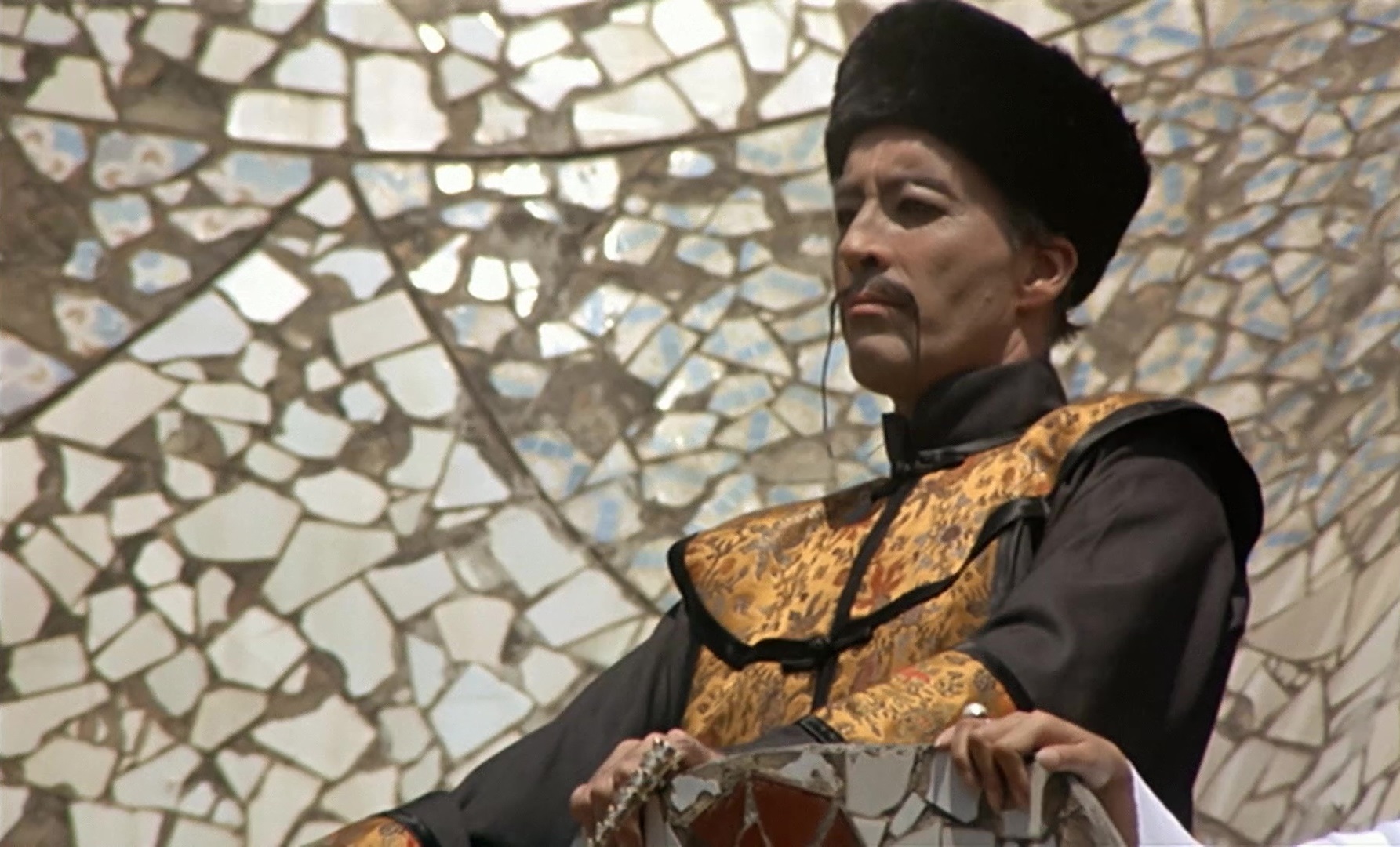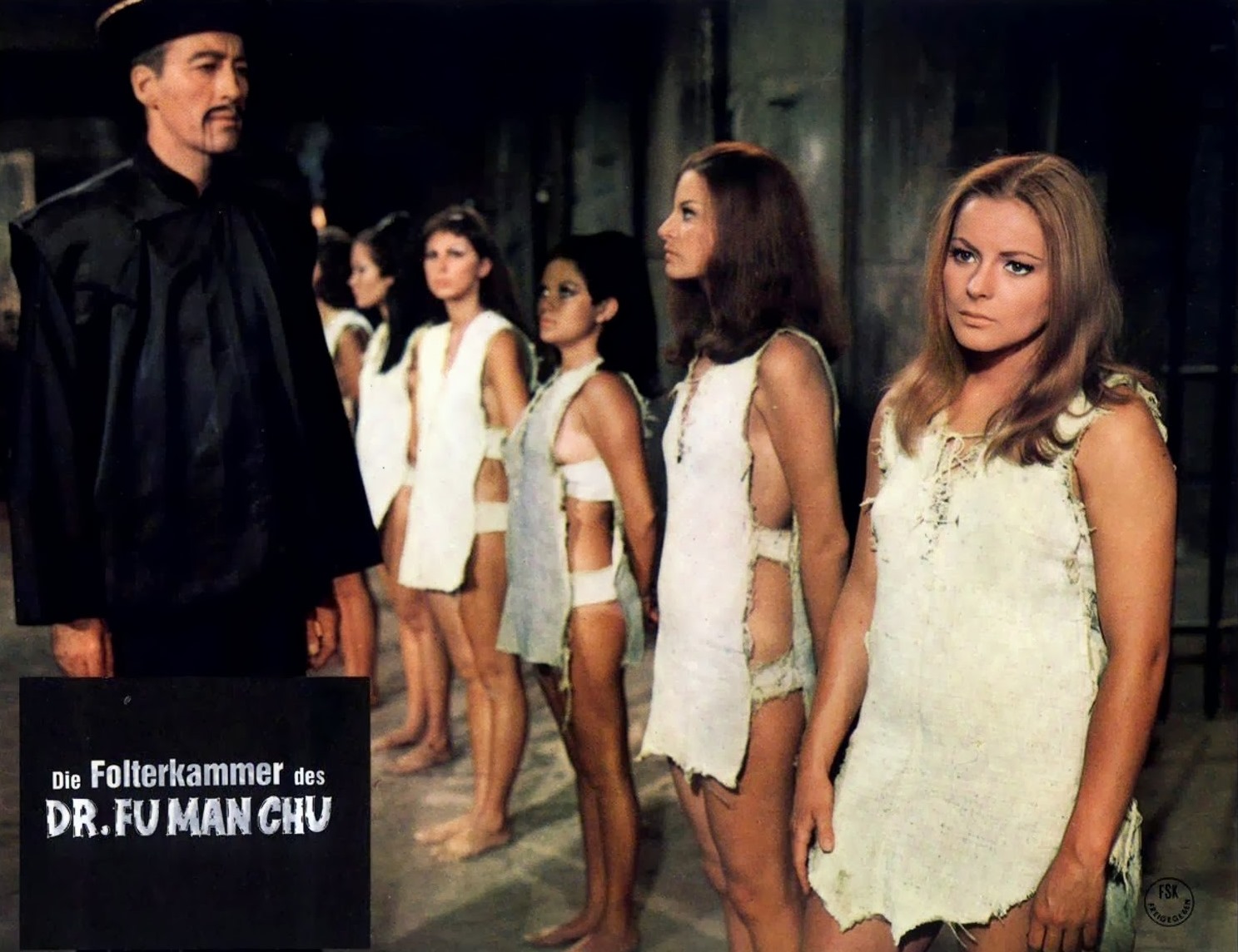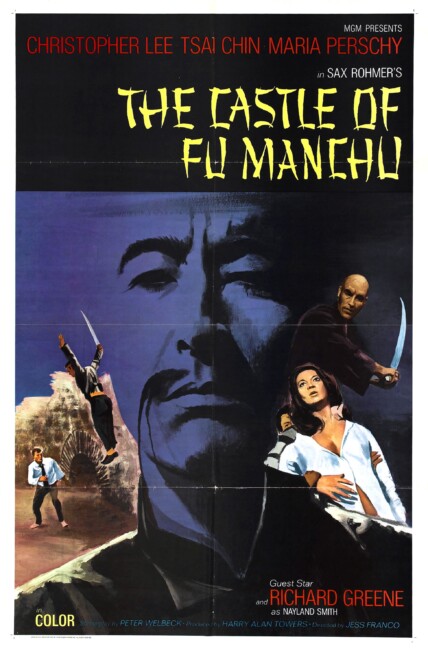aka Assignment Istanbul; The Torture Chamber of Fu Manchu
West Germany/Italy/Liechtenstein/Spain/UK. 1969.
Crew
Director – Jess Franco, Screenplay – Peter Welbeck [Harry Alan Towers], Based on the Characters Created by Sax Rohmer, Producer – Harry Alan Towers, Photography – Manuel Merino, Music – Charles Camilleri. Production Company – Towers of London (Films) Inc.
Cast
Christopher Lee (Fu Manchu), Richard Greene (Sir Dennis Nayland Smith), Tsai Chin (Lin Tang), Howard Marion Crawford (Dr Petrie), Gunther Stoll (Dr Curt Kessler), Maria Perschy (Marie), Rosalba Neri (Lisa), Jose Manuel Martin (Omar Pasha), [uncredited] Jess Franco (Inspector Ahmet), Werner Aprelat (Melnik)
Plot
Fu Manchu attempts to perfect a chemical process that will turn large sections of the sea to ice. Realising what Fu Manchu is doing, Sir Dennis Nayland Smith is certain that he will attempt to set up operations in Istanbul because of its easy access to The Bosphorus. Just as Nayland Smith predicts, Fu Manchu captures Anatolia Castle in a raid and sets up operations there. Fu Manchu has abducted Professor A.G. Heracles, whom he needs to complete the freezing process. However, Heracles has a bad heart and so Fu Manchu is forced to also abduct Dr Curt Kessler and make him perform a heart transplant from a perfectly healthy living donor.
The Castle of Fu Manchu was the fifth and last of the Fu Manchu films made during the 1960s by producer Harry Alan Towers and starring Christopher Lee. Based on Sax Rohmer’s famous Chinese super-villain who appeared in thirteen novels between 1913 and 1959, the film series began with the excellent The Face of Fu Manchu (1965) and continued through two sequels The Brides of Fu Manchu (1966) and The Vengeance of Fu Manchu (1967).
The last two entries in the series – The Blood of Fu Manchu (1968) and The Castle of Fu Manchu, which are usually known under a bevy of different names mostly in an attempt to market them as part of the 1960s spy film fad – are the most contentious. With these, Towers brought on board Spanish exploitation director Jesus/Jess Franco. Franco was one of the most prolific directors in the world, having made nearly 200 films in almost every conceivable genre between the 1960s and his death in 2013. A frequent number of Franco’s films feature high degrees of sex and gratuitous on-screen cruelty if not outright sadism. (See below for a list of Franco’s films). An uncredited Franco can be seen on screen here playing the role of the Turkish police inspector.
The previous Towers-Lee Fu Manchu films were reasonably budgeted but the Jess Franco entries became increasingly impoverished, reaching their nadir with The Castle of Fu Manchu. This is particularly evident where one sees that all the major effects set-pieces have been taken from other films. The opening scene features a ship that is sunken at sea when Fu Manchu freezes areas of the ocean, where this is represented by footage taken from the Titanic film A Night to Remember (1958) [which bears an uncanny resemblance to scenes in James Cameron’s Titanic (1997) to the point that one wonders what material from that film is doing in one that was made thirty years earlier]. There is also footage taken from another unidentified film when it comes to the flooding of the dam (we are never sure how this relates to Fu Manchu’s water-freezing plan as we never see any water being frozen prior to the dam bursting). In both of these cases, the quality of special effects are far superior to anything else in the film and immediately signifies the difference in obvious ways.

Fu Manchu’s world domination plot this time – freezing sections of the ocean – has become an even more outlandish and outrightly science-fictional one that belongs more in the stratosphere of schemes employed by James Bond super-villains. In actuality, this pans out as a routine plot – the same sort of plotting familiar to numerous serials – of the good guys following the trail of an abducted scientists and then of another scientist who has been abducted in order to heal the first scientist and so on. The film has its odd moments like where the abducted Professor Heracles complains “My heart is dying,” to be told by Christopher Lee “There are younger hearts in the world. Stronger hearts,” whereupon Franco cuts to Tsai Chin standing with a topless beefcake male beside her.
Mostly, Franco’s pace is slow and monotonous. For some reason, Franco has cut down on the sex and sadism elements that he allowed to enter into The Blood of Fu Manchu. Unfortunately, this leaves The Castle of Fu Manchu reliant on other things – like plot, drama and action – none of which Franco has demonstrated much of an aptitude for elsewhere. The film is dull – it is slow moving and has an almost totally uneventful plot. Some of his directorial set-ups are bizarre – like the laboratory sequence, which is comprised only of shots of boiling coloured beakers. One of the most bizarre sequences is the heart transplant operation that comes focused entirely on closeups of hands, a clock ticking and the blank white wall rather than any of the doctors or the patient, and is all run over by a monotonous score.
The only thing that The Castle of Fu Manchu has going for it is the wonderfully icy and autocratic presence of Christopher Lee, although by now even he appears to be giving his performance on autopilot. Tsai Chin also has great presence but she, as she was throughout the rest of the series, is underused. Richard Greene is a capably solid Nayland Smith once again. Howard Marion Crawford keeps going through the old duffer routine that he played in all of the Towers-Lee Fu Manchu films but by now has become too much of an easy comic foil – he being introduced fishing and getting his line tangled in a tree, finding the fish is too small etc.
The one good thing about Jess Franco’s Fu Manchu films was that he was prepared to travel to different parts of the world to film – The Blood of Fu Manchu was shot in Spain and Brazil, while The Castle of Fu Manchu takes the series to Turkey (where Franco made a number of other films around the same time). Franco does make good use of the Istanbul locations and achieves an effective background flavour of Turkish culture.

The other Fu Manchu films include:– a series of 23 short silent British films made between 1923 and 1924 starring H. Agar Lyons as Fu Manchu, all of which appear to be lost today; three early sound films from Paramount, The Mysterious Dr. Fu Manchu (1929), The Return of Dr Fu Manchu (1930) and Daughter of the Dragon (1931), starring Warner Oland who later gained fame as Charlie Chan; the excellent The Mask of Fu Manchu (1932) with Boris Karloff; a fifteen chapter serial The Drums of Fu Manchu (1940) from Republic starring Henry Brandon; the tv series The Adventures of Fu Manchu (1956), which only lasted for eleven episodes, starring Glen Gordon; and The Fiendish Plot of Dr Fu Manchu (1980), a parody that featured Peter Sellers in his last performance playing both Fu Manchu and Nayland Smith. Harry Alan Towers also produced several films based on Sax Rohmer’s Sumuru books about a female super-villain with The Million Eyes of Sumuru (1967), the Jess Franco directed The Girl from Rio (1969), both starring Shirley Eaton, and Sumuru (2003) starring Alexandra Kamp.
Jess Franco’s other films:– The Awful Dr Orloff (1962), The Sadistic Baron Von Klaus (1962), The Secret of Dr Orloff (1964), Attack of the Robots (1966), The Diabolical Dr Z/Miss Death (1966), Necronomicon/Succubus (1968), Justine (1969), Kiss Me Monster (1969), 99 Women (1969), Sadisterotica/Red Lips (1969), The Girl from Rio (1969), Venus in Furs (1969), The Bloody Judge/Night of the Blood Monster (1970), Count Dracula (1970), Eugenie/Philosophy in the Boudoir (1970), Nightmares Come at Night (1970), Vampyros Lesbos (1970), Dracula, Prisoner of Frankenstein (1971), She Killed in Ecstasy (1971), The Corpse Packs His Bags (1972), The Daughter of Dracula (1972), The Demons (1972), Doctor Mabuse (1972), The Erotic Adventures of Frankenstein (1972), The Silence of the Tomb (1972), The Bare-Breasted Countess/Erotikill/Female Vampire (1973), The Erotic Adventures of Maciste in Atlantis (1973), The Obscene Mirror/The Other Side of the Mirror (1973), The Sinister Eyes of Dr Orloff (1973), A Virgin Among the Living Dead/Christina, Princess of Eroticism (1973), Lorna the Exorcist (1974), Night of the AssassinsNight of the Skull (1974), The Perverse Countess (1974), Eugenie (1975), Doriana Grey (1976), Jack the Ripper (1976), Sexy Sisters/Satanic Sisters (1976), Greta the Mad Butcher/Wanda the Wicked Warden/Ilsa: Absolute Power (1977), Call of the Blonde Goddess/Voodoo Passion (1977), Wicked Women (1977), Demoniac/Exorcism/The Ripper of Notre Dame (1979), Man Hunter/The Devil Hunter (1980), White Cannibal Queen (1980), Bloody Moon (1981), Oasis of the Zombies (1981), Revenge of the House of Usher (1982), Grave of the Living Dead (1983), The Treasure of the White Goddess (1983), The Sinister Dr Orloff (1984), Mansion of the Living Dead (1985), Faceless (1987), The Killer Barbies (1996), Lust for Frankenstein (1998), Marie-Cookie and the Killer Tarantula in 8 Legs to Love You (1998), Tender Flesh (1998), Vampire Blues (1999), Vampire Junction (2001), Incubus (2002), Killer Barbies vs Dracula (2002), Snakewoman (2005), Paula-Paula (2010), Al Pereira vs the Alligator Ladies (2012), Crypt of the Condemned (2012) and Revenge of the Alligator Ladies (2013).
Trailer here


